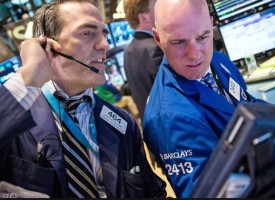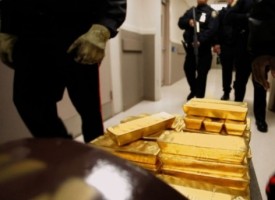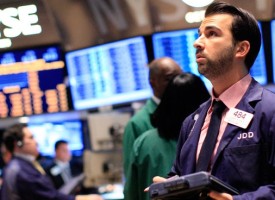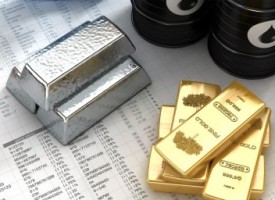With the stock market rallying on the heels of the public betting big on a stock market crash, today the man who is connected at the highest levels in China says we are in the early stages of the Commodity SuperCycle, hyperinflation, and the final phase of the war in the gold market.
Gold: The Endless War
May 17 (King World News) – John Ing: In 1991 the Soviet Union collapsed, the Berlin Wall came down in Germany and 15 newly independent nations including Ukraine were born, ending the Cold War peacefully. The end was only a hiatus however. Today, disruption is everywhere and global tensions are reshaping the world order. Start with the draconian financial sanctions, confiscation of assets and the weaponization of commodity markets as part of the West’s declaration of financial war against Russia in response to its brutal invasion of Ukraine. Yet, the Ukraine invasion reveals deeper fault lines. Europe is split in its response. China remains on the sidelines. The important Middle East energy bloc has no interest in abandoning relations with China, the largest oil consumer or, breaking ties with Russia. Asia too has joined China, dividing the post-war Washington led order which began after World War II with the Marshall Plan rebuilding Europe and for half a century, free trade, globalisation and technology cemented America’s leadership role. That has changed. Today, the Russian economy has nosedived, locked out of Western finance and commerce, and mired in an “endless” war that neither side knows how to win or willing to lose.
The Russian war has framed the global stakes as a contest between a distinct two-polar world order with a Washington-centric and ascendant Beijing-led order. Noteworthy too is that in the last two decades as the US weaponized the dollar, its share of total exchange reserves has declined below 60% due in part to usage of the euro and yuan. The seizure of assets, the imposition of wide-ranging sanctions and tariffs while furthers Washington’s interests, also undermines faith and trust in the dollar.
Energy, The Lack Thereof
With the change in the world order, Russia’s financial isolation grows with widespread shortages of raw materials, especially for energy and food having major repercussions that will reverberate throughout the global economy. First, any return to normal is unlikely while Mr. Putin remains in power. Second, in the never normal there is the likelihood of a Russian default on some $120 billion of dollar denominated debt as a result of the fallout from the US Treasury’s refusal to let US banks process payments on Russian government debt. Though wrenching, the confiscation of half of Russia’s $640 billion in gold and foreign currency reserves exposes a stealth currency war and in bringing out into the open, ensures Russia’s first foreign debt default since 1918.
Consider energy and food. Energy issues were a major contributor to Putin’s war. Russia’s invasion has created a full-blown global energy shock, underpinning an already escalating inflation problem which has put climate change on the backburner and, ironically accelerated global warming. The stakes are high. Energy has become a tool of war, exposing the West’s energy vulnerability. Leaving aside who is winning or losing, it is clear that we face protracted energy, capital and financial chaos. Noteworthy is that Russia’s energy sector is keeping that country afloat, benefiting from the higher prices brought on by its attack on Ukraine, producing a surplus in the latest quarter, despite the sanctions.
Not widely known is that 20% of US electricity generation is from uranium of which 90% is imported, some from Russia, the third largest supplier. In response to sanctions, state- controlled Gazprom threatened to suspend gas supplies to Europe unless they receive rubles rather than dollars or euros, as required under their contracts. NATO members Poland and Bulgaria refused and subsequently supplies were suspended in an escalation of tensions. Gas prices spiked and are six times higher than a year ago. Notwithstanding the ban by the US, UK, Canada and Australia, Europe is still buying Russian oil in an old-style blackmarket scheme, enabling Russia to sidestep the sanctions. The EU alone sends €1 billion to Russia every day to pay for its energy bill that covers about half of Russia’s budgetary needs.
What is more, the escalation over natural gas payments comes at a difficult time since Europe has yet to replace Russian imports of 40% gas and 26% of its oil used to heat homes and produce electricity. Consequently, Europe is divided on how best to manage the next stage including a phased embargo as European energy needs become the front lines in the Ukraine war.
Europe’s heavy reliance on Russian gas also widened the split among America’s allies. America’s two biggest oil allies, Saudi Arabia and UAE have spare capacity, but rebuffed Mr. Biden’s pleas for production boosts because the Gulf states are still smarting from America’s ignoring their security concerns, after attacks on their energy infrastructure. Instead of undercutting Moscow and reducing prices, they invited America’s arch rival, China for talks on swapping oil for yuan, creating a petroyuan to rival the petrodollar. The Saudis no longer sell much oil to the US and instead have become the biggest supplier to China.
Left with few options to help Europe, the United States, one of the world’s largest natural gas exporters pledged to add 15 bcm meters of liquefied natural gas (LNG) to Europe this year. The US shipped 22 bcm meters of gas to Europe in 2021 and already sent 10 bcm in the first quarter of this year, according to Refinitiv. However because the EU imports roughly 50 bcm from Russia, it is not enough. While Qatar for example is a top-tier LNG exporter to Japan and South Korea, there is little spare capacity to help Germany, the largest EU buyer of Russian oil and gas. The Bundesbank disclosed that an immediate EU ban on Russian gas would cost Germany $177 billion in lost output, which would trigger one of the deepest recessions.
There is also a mad scramble to build multi-billion dollar LNG terminals and pipelines which require long term contracts and cost billions and years to build. Germany today in fact has no LNG facilities. Canada once had seven LNG projects, but after heavy government regulations and NIMBY opposition, only one is being built on the westcoast. Left unsaid is that although liquifying natural gas is energy and carbon intensive, it remains in scarce supply and will simply go to the highest bidder, sanctions or no sanctions, testing the global green pledge to reduce carbon emissions.
Food, the Lack Thereof
Alongside, the critical food supply chain was broken, broadening into crisis proportions, including rationing, famine and political upheavals. The developing world is particularly reliant on Ukraine for crucial food supplies as upheavals in grain markets push up global prices for food, fuel and fertilizers, exposing the vulnerability of food chains triggering fears of a repeat of the food crises that caused political upheavals in poorer nations. Global food prices had already reached records before Russia invaded Ukraine.
Russia’s invasion has blocked the planting of corn, wheat and sunflower oil from one of the world’s largest food exporters, particularly to the developing world. Prices had skyrocketed already, adding to inflationary pressures. With ports blocked, fields laden with Russian mines and equipment shortages together with a shortage of fuel and fertilizers, Ukraine’s agricultural industry is at a standstill. The US Department of Agriculture (USDA) estimates that Ukraine provides 10% of global wheat exports, 14% of corn and half of the world’s sunflower oil used for cooking. As a result, the World Bank has warned of a global food catastrophe. At the same time, there are droughts in North America and Brazil, which will mean severe food shortages, skyrocketing prices and famine for some countries.
In response to surging domestic food prices, Indonesia the world’s largest cooking oil supplier banned palm oil exports, triggering global shortages and rising protectionist policies that disrupted food markets. While financial distress is contributing to political instability, risk is back, particularly the intangible or exogenous risk that can no longer be quantified by the algorithms, contributing to huge swings in market volatility and the soaring price of “everything”, sustained in supercycle fashion. If food and energy inflationary pressures are unaddressed, this could lead to the stagflation of the seventies, because the US economy shrank in the first quarter by 1.4%.
Political Costs
It matters because America consumes 20 million barrels of oil a day and despite a 40% climb in prices to the highest levels since 2008, there has been little increase in supplies. The challenge is vast because of Mr. Biden’s schizophrenic “climate change” agenda and the demonization of his own domestic industry has blocked investments in new production, infrastructure and even pipelines, ironically a major reason for the 50% increase in gasoline prices, fueling higher inflation. Also, ESG mandated restrictions encouraged investment in renewables at the expense of fossil fuels, resulting in underinvestment in US shale production, which declined for the first time in years. And, although Mr. Biden needs the industry to pump more oil, he blames them saying, “oil and gas companies shouldn’t pad their projects at the expense of hardworking Americans”. Politically deaf, his mixed messages alone will jeopardize his party’s control of Congress in the November midterms, particularly when his polling is at only 33%.
And aside from political will, the challenge to increase both renewables and fossil fuel production requires big capital and years to boost production. Of concern is that nominal energy costs to GDP has climbed to 40-year highs at 15% of GDP, up from an average of 5% with the 10-percentage differential now devoted to energy consumption, not productivity, not investment, nor savings. And today the acute shortage of large-scale new projects and thus supply is made worse by Mr. Biden’s blocking of pipelines in a NIMBY greener world. In North America for example, the important Keystone XL Pipeline was blocked for environmental reasons and if built, would today be shipping Alberta and American crude to the southern parts of the United States, partly alleviating the supply issue. Instead to bring down prices, this president released 180 million barrels of crude oil from the US Emergency Reserve on hopes that prices will fall in time for the November midterms. However his political move also undercuts his climate change agenda, popular with younger voters. And while the release temporarily reduced gas prices, the strategic reserve will need to be replaced and as prices decline, the more Americans use, the more taxpayers will pay.
The End of Globalisation?
All this is inherently inflationary. The blockage of the Suez Canal first exposed the vulnerability of supply chains such that a shortage of semiconductors adversely impacted the automobile industry, resulting in stoppages of production. For decades outsourcing had become much more efficient with supply chains enabling companies to take advantage of lower labour costs and tax jurisdictions of different countries. But recent trade protectionism, tech wars and political nationalism exacerbate a global protectionist push exposing structural weaknesses with clogged ports, rising labour costs and even driver shortages. The pandemic also caused worker shortages and red hot labour markets because workers were paid to stay at home. Unfulfilled job openings in the US surpass unemployed workers by a record 5.6 million. Amazon workers recently made history, joining the Teamsters Union that may spur union growth after decades of decline as tight labour markets increase labour costs, reminiscent of the labour woes in the 70s, pushing up inflation…
To find out which gold & copper explorer just hit significant mineralization click here or on the image below

The relationship between China and the United States also shaped the world’s future. For three decades with the advent of financial liberalism, countries such as China and India joined the global economy. China became the workshop of the world matching America on many dimensions. After the break-up of the Soviet Union, Russia grew to the 11th largest economy as gas exports rose eight times becoming the major supplier to Europe. Russia’s Gazprom produces more gas than BP, Chevron and Aramco combined. India grew into one of the world’s largest democracies. Ukraine became part of the breadbasket to the world. This global growth was due to free trade and globalisation as supply chains turbocharged markets. But then disrupted by the Wall Street crash, trade peaked as a percentage of the global economy in 2008. Since then realpolitiks has taken over with China emerging as an archrival to the United States and both sides have a growing distrust of the other.
Donald Trump’s trade war with China weakened the supply chains as deglobalisation became a fact of life. The relationship between China and the United States deteriorated further when China stayed on the sidelines in the Ukraine war. Graham Allison of Harvard believes the United States has fallen into the “Thucydides Trap” in which history shows that when a rising power, clashed with an established one, 12 of 16 episodes ended in bloodshed. Noteworthy of the four episodes that ended peacefully, in the twenties the world’s key reserve currency then was British sterling.
But after the cost of two World Wars weakened Britain’s financial strength, Britain lost its great power status when sterling could not handle the strain and the gold standard was scrapped, to be replaced by the American dollar. In 1971, after fighting the Vietnam War, the United States could no longer redeem dollars for gold and like Britain was forced to sever the dollar’s gold backing, devaluing the dollar. And today like Britain, the United States has racked up a monumental debt load on a horrific scale and the fiat dollar is poised to lose its crown. And this time China is at the epicenter leading the economies of southeast Asia, wielding great financial power. Hopefully the next changeover will be peaceful since the dollar is not forever.
In similar fashion, deglobalisation has proven inflationary, more like the 1970s-style supply- side shock when two oil embargos and a series of food price shocks, eventually led Fed Chair Paul Volcker to hike rates to double-digit levels to stop inflation at a cost of crushing the US economy, pushing unemployment to 11% causing two serious recessions. Today, amid surging prices for everything from semiconductor chips to wheat to nickel to uranium, the inflation fires again burn brighter. The Fed like then promised to apply the monetary brakes but monetary policy remains too loose. While there are concerns that global growth will falter in the wake of the Soviet invasion, the unprecedented sanctions and fears of tightening by the big central banks has caused mounting stress in the commodity markets and the backwardation of oil, copper and interest rates. Yet the market remains complacent. Even with the increase in the fed fund rate, the move is hardly disinflationary. If the Fed doubled today’s rate, real interest rates would still remain negative. The interest rate on the 10-year US Treasury note hovers around 3.00% while inflation clocked at 8.3% in April and is still rising. It is not so different this time.
Supercycle Me
And after three decades of disappearing inflation, the return of inflation has caught everyone, including the Fed by surprise. Commodities posted their best quarter on record distorted by the huge pandemic outpouring of paper currencies. Inflation was already high in the United States, having risen in each of the 12 months before Russia’s invasion. War, sanctions and natural disasters all threaten commodity supply chains, sustaining we believe, a rare supercycle trend where demand drives prices well above their long-term trend for an extended period. The supply chain bottlenecks once viewed temporary are now semi-permanent. It is the dearth of supplies and scarcity inputs in the face of resurgent demand that surprises policymakers. Yet the lack of investment is a culprit as consumption is considered more important than investment.
The recent shocks surprised investors as to severity and length. Inflation had earlier been sharply rising in the past year fueled by the era of massive government spending and negative interest rates which bolstered asset prices leaving investors and households addicted to cheap money. But now the Ukraine war and China’s recent lockdowns have turbocharged food and energy inflation as massive supply shocks boosted prices recreating a perfect economic storm, reminiscent of the seventies of slow growth, near hyperinflation and a commodity supercycle. Wheat and oil are both about 50% higher than a year ago. Also sustaining the supercycle and fanning inflation is the huge cost required to bolster the world’s defense and postwar reconstruction.
But This Isn’t Even Putin’s Inflation
Broken financial, food and energy supply chains were part of the problem but beyond the supply chains, other 21st century critical areas need to be addressed such as AI, semiconductors, clean energy, biotech, and quantum physics. The green boom itself earlier caused shortages of critical metals as the world became dependant on China and Russia for supplies. Copper, nickel and gold can be dug out of the ground but new mines won’t be constructed, until the next decade at the earliest. And, where or what energy will fuel the expansion? Today there is an unprecedented competition for these resources as every government tries for the same goal of self-sufficiency and energy independence, underpinning inflation. Add in political risk to the lack of investment dollars and government inertia, the supercycle has returned…
One Of The Best Silver Plays In The World Just Became
One Of The Best Gold Play In The World!
TO LEARN MORE CLICK
HERE OR BELOW.
Another good example of out-of-wack commodity markets was the recent nickel debacle on the London Metal Exchange (LME) which resulted in a whopping $8 billion loss after a Chinese nickel giant (Tsingshan) failed to come up with margin that prompted Europe’s largest commodity trading houses to seek state aid. Commodity trading giants Vitol, Glencore and Trafigura, heavily reliant on financing from banks were forced to put up more margin on their derivative contracts because in the world of buying and selling, they often took the opposite side of the trade. And surprisingly the dominant players in this largely unregulated physical market often offloaded their liabilities on the futures market, were caught offside as the spike in commodity prices forced those market players to face billion-dollar losses as their one-way bets reversed themselves, not dissimilar to 2008 when toxic sub-prime derivatives tied to homes, imploded causing the collapse of Long-Term Capital Management in the nineties. Then a build- up in massive concentrated leverage positions in “risk free” assets, later turned out to be anything but, costing billions of losses showing how a small exposure to leverage can cost serious money.
Yet we are only in round one of the stress in the markets. Round two is the recent yield curve reversion which has traditionally been a classic harbinger of an economic downturn as short dated two-year notes are now higher than the long dated 10-year Treasuries, for the first time since 2019. Prices of long bonds have fallen heavily. The last time inflation was this high, the Fed engineered a severe recession. However this time they have done too little to arrest the forces that drive inflation and yet they keep promising a tighter policy. What if the markets conclude that interest rates need to go even higher? Of concern is that the big Wall Street banks’ balance sheets would again bear the brunt of central bank policies at a time when a Russian default or financial implosion could seize up an already stressed financial ecosystem and, in the middle of a geopolitical crisis. Is it different this time?
Inflation Genie Out of the Bottle
All this comes at a definitive moment. After the Fed struggled to lift inflation to a 2% inflation target for the past two decades, they surprised themselves when they succeeded, but now view the uptick as transitory, and face the opposite problem with entrenched inflation four times their target at 8.3%, a four-decade high. Even “core” inflation (without energy and food) was 6.2%. And still the Fed remains behind the curve, timidly raising rates after Canada and New Zealand had already raised rates by 50 basis points. Inflation’s principal cause is too much government spending. And with the inflation genie out of the bottle, created by decades of money printing through quantitative easing, MMT and Covid stimulus, we have a case of too much money chasing too few goods as inflationary pressures spread from goods to services. Economic growth has outstripped the economy’s capacity to supply goods and services. Governments and central banks tried to control inflation in the late sixties, but they waited too long and failed to curb excess demand, letting prices and wages feed themselves resulting in the double-digit inflation and near hyperinflation in the seventies. Is it different this time?
No. Mr. Biden’s $5.9 trillion government budget proposed $2.6 trillion in new taxes, including a 20% “tax the rich” tax, a populist move made worse by the poor state of America’s public finances. The US economy is highly leveraged and has a massive structural problem of too much debt. In March 2020, US money supply was $16 trillion, its now $22 trillion after three rounds of government stimulus programmes topped 25% of GDP. The Fed’s balance sheet doubled to $9 trillion during Covid. For markets this translated into abundant liquidity as the newly created money helped create the biggest stock market boom in history, in what seems, the bubble that never burst. Mr. Biden also created one of the world’s largest entitlement states, resulting in a soaring “made in America” inflation and now declining growth. US national debt today is at 130% of GDP. We have long argued that this period most resembles the near-hyperinflation of the 70’s than any other period, from the central bank complacency, to the easy money bubble- like conditions, to negative interest rates and of course record debt levels. It is not so different this time.
Consider that consumer spending which makes up about 70% of America’s GDP has rebounded, fueled by the government’s three stimulus programmes which helped contribute to the growing current account deficit as consumer spending boosted imports from abroad. And as companies export less, more dollars are sent overseas. Some foreign investors have gone on strike because they already have too many dollars. Instead some of those dollars are being used to purchase commodities, gold and even Russian oil for yuan, undermining the greenback’s value. In the modern-day era of fiat currencies, the effect of reflationary policies is to devalue paper currencies relative to storehouses of wealth. And as America fails to curb inflation, its global influence will shrink, ushering in a new era of currency disorder. For America, the war’s collateral damage will prove costly.
Taxes Are Not Enough
The political strategy behind Bidenomics is simple. After running up record debt with the biggest spending blitz in history to pay for this, raise taxes. What Biden didn’t tell anyone is that his “billionaire tax” applies to all income including unrealized capital gains, not just income which in fact widens the catchment basin, hurting more than the wealthy class. If the Elon Musks, Bezos and Tim Cooks went along, they would only come up with a paltry $215 billion, not much to make a dent in the $30 trillion debt load owed to the public. Thus the need for a wider net and possibly tax a wider pool of homeowners sitting on million-dollar homes who might discover that under the tax they have to hand over $200,000 every year to pay for his or her share.
Mr. Biden also left unchanged Donald Trump’s signature $1.9 trillion tax bill (Tax Cuts and Jobs Act) that slashed the corporate tax rate to 21% from 35%. And, despite promises of “quantitative tightening” to shrink the Fed’s gargantuan $9 trillion bond portfolio built up during the pandemic to support financial markets, any reduction would conflict with Mr. Biden’s proposal to spend 31%, well above the average 21% spent as a share of GDP between 1972 and 2021. Consequently despite the Fed’s tough rhetoric, the Fed’s balance sheet must keep expanding because foreign funding has gone missing. Inflation is deeply entrenched in Mr. Biden’s tax increases, subsidies and increased regulation. Because of his government’s insatiable appetite for spending, the result has been stubbornly high inflation and declining economic growth. Nonetheless Mr. Biden and his party (Manchin excluded) are pushing towards another trillion dollar “Building a Better America” aka “Build Back Better” bill. Hyperinflation now?
After getting inflation wrong, can the Fed get in right this time? Despite hawkish rhetoric that runs far ahead of reality, the Fed remains reluctant to apply the necessary monetary brakes and continues to support negative interest rates, stoking demand not supply. Needed is for the Fed and the administration to “walk the talk”, but they have done little to mitigate the problem. The Fed earlier viewed 2%-3% as “neutral” when inflation was 2%. The record half percentage rate increase, the first in two decades only brings the rate to 0.50% to 0.75%, far shy of neutral or historic averages particularly when inflation today is close to 9%. Instead of “tough” rhetoric, the Fed remains timidly late in raising interest rates or even shrinking its bloated balance sheet admittedly difficult if not impossible in a midterm election year. If not then but when, because in 2024, Mr. Biden will be 82 years old and a much younger candidate at 75 years, Donald Trump is president – in waiting.
The Unraveling of The US Dollar
The US dollar is the world’s reserve currency. More than half of central banks’ stockpiles are invested in dollar denominated assets such as US Treasuries. Its primacy owes as much to the fact that there were few good alternatives to the currency. However, as the world uses less dollars and with the formation of multi-polar blocs, America’s hegemonic status has crumbled under their currency debasement, western sanctions and geopolitical tilt against those who disagree with its foreign policy particularly since roughly 49% of global trade is in dollars, while America’s share of exports is only 10%. The war, America’s sanctions and the emergence of both currency and trading alternatives is testing the dollar’s “exorbitant” privilege such that other countries including America’s allies view that privilege as an abuse of power.
Our view is that America’s Achilles heel is the $17 trillion of America’s liabilities held offshore. This continuous rise in the external deficit in a savings-short US economy is unsustainable. America’s weaponization of its currency and confiscation of half of Russia’s $637 billion in currency and gold reserves is a wake-up call to dollar holders having spillover effects pushing Russia and others to conduct trade in other currencies. It has happened before, in Iran and recently, when the US froze Afghanistan’s reserves after the Taliban took over. America’s hegemonic status is fragile, as is its fiat currency…
Look At Who Is A Big Investor In This Soon-To-Be Self Funding Gold Exploration Company! To learn more click here or on the image below.
And the usage of the Western SWIFT payment nuclear bomb to deny Russia access to the dollar has changed the calculus forcing other governments to question their dependence on the US dollar hegemony and explore alternatives to their dollar dependence. Russia too has alternatives. Hungary will pay for their oil in rubles. The EU still needs Russian gas and oil and some have opted out of dollars. Chinese steel producers are paying for iron ore in yuan. China, Japan and India, the world’s largest energy consumers are likely to purchase surplus oil and gas from Russia, but at bigger discounts of course and, in their own currencies. Steering clear of America, China intends to boost domestic production and build more energy and financial partnerships, “expanding its circle of friends”. A post-Russia and post-China world will deepen that effort, as China becomes a clearing house for Russian transactions and others, further undermining America’s financial hegemony. As well, the greater use of digital currencies lessens the need for dollars because cross border payments can be made with a click.
China’s $3.2 trillion of foreign exchange reserves gives it plenty of ammunition to claim leadership in any new monetary order. China is nurturing its capital markets, easing foreign ownership laws and payment system to internationalize their currency allowing them to play a bigger role in international finance as the world’s largest trader. However the lack of currency conversion hinders the full globalisation of its currency. They and others are no doubt watching developments as they must decide that holding reserves in any currency, particularly the US dollar is risky if they want to avoid a similar fate. That America’s rivals want to escape dollar dominance is no surprise. More telling is that its allies are flirting with it too.
For example India, the world’s largest democracy was conspicuously silent in its response to the Ukraine war. Noteworthy too is that while China’s partnership with Russia remains intact, and Xi’s “no limit” declaration is being put to a test, China is also Ukraine’s biggest trading partner. China’s balancing act of strategic neutrality has been joined by others. OPEC’s refusal to join the sanctions and the acceptance of the petroyuan instead of petrodollars only reinforces China’s influence as a Beijing-centric Euroasian basket competes with Western influence, and markets. Meantime American dysfunctional politics, and heavy-handed bully treatment of their dollar has prompted other central banks to move out of dollar denominated assets for reasons both economic and political and, instead invest into alternatives like gold, currency baskets or even stockpiles of crucial commodities, further fragmentating the world order.
Bypassing the dollar-based US financial system is a start. US government debt in the past half century has been central banks’ preferred investment to park money but threats to delist, sanctions and seizures are weapons in today’s currency war. Then there are worries about America’s credit worthiness, reminiscent of the early seventies when Richard Nixon severed the dollar’s link with gold – a defacto default. The more politicised the dollar becomes, the less reliable as an asset of last resort. In becoming the largest debtor in the world, confidence in the dollar is eroded with debt to GDP at the highest ever. America has operated a reckless financial system whose main characteristics are excessive money growth, over-extended stimulus, and rising debt. Today foreign money led by the Chinese, the world’s largest creditor holds a third of the debt of the world’s largest debtor and when their underlying security is dependent upon US policy whims, who will buy tomorrow’s future tranches of American debt?
What damages trust in the US, damages the world. About 60% of the world’s assets are denominated in a fiat currency used by a country whose authorities are taking policy actions that debases their currency. The weaponization of the dollar could boomerang on America. The dollar is not forever. Gold is a good thing to have, it is the alternative global currency.
Oh Canada
But it is not just America that is the profligate spender, spending beyond their means. There is its neighbour to the north, Canada. Canada has fallen behind US GDP, seen its business sector falter and is last in G7 GDP growth. And it will get worse since the government’s pact with the left wing NDP commits the government’s budget to more than $56 billion of new spending to stay in power. Finance Minister Chrystia Freeland frankly admitted, “We are falling behind when it comes to economic production”. It matters because Canada recently had its credit rating downgraded by Fitch to double A+ from triple A. At the end of 2019, the deficit was $20 billion and our $700 billion debt has grown to $1.2 trillion in only 2 years. In Freeland’s budget, billions from the oil windfall is to be spent on children’s dental care, climate change and social justice issues, all worthy causes but her government has done little to boost supplies, curb inflation or its effects.
Frustrated with the country’s direction, the head of Scotiabank, Brian Porter called unsuccessfully for an Economic Commission to boost Canada’s competitiveness, or help with the transition to cleaner energy. Canada has a golden opportunity to provide the world with scarce energy, food and minerals. Instead this government fuels more inflation, spending more than they take in and the mismatch between spending and revenues grows such that federal debt to GDP has climbed 50% in the Trudeau years. Given the new world disorder, in a world of scarce resources, why hasn’t Canada pushed to boost capacity of energy and resources? Ottawa instead will spend billions stoking demand for housing in an already hot market created in part by the government’s near zero interest rates giving homebuyers “free money” to buy their homes, rather than fix a creaking healthcare system.
On that, it took the Covid crisis to expose the parlous state of Canada’s healthcare system despite boasting about its public-funded Medicare. Billions could have been spent on improving a weakened health care system which had waiting lists, medical personal shortages as our doctors and nurses were left high and dry by the government’s spending on “other social issues”. More could have spent on PPE, vaccines and hospital beds. Draconian lockdowns, lineups and quotas were the norm because our hospitals were at capacity. Why? Canada’s overall hospital beds per 1,000 people for OECD countries is a dismal close to last reflecting the parlous state of healthcare, with fewer hospital beds than the majority of OECD countries. And when the Freedom Convoy demonstrated in front of Parliament Hill, the government arrested, confiscated their assets and for the first time ever, imposed the Emergencies Act on its own citizens who were only protesting the lack of freedoms – maybe they should have protested the lack of beds.
And today, Canada ranks close to the bottom in defense spending, even after Freeland’s budget boosted defense spending to 1.5% over 5 years, up from a paltry 1.3%, far short of our 2% NATO pledge. Canada can’t even walk the talk as the budget proposes to spend more on children’s dental care than defending ourselves. This government, as most Western governments ignore the reality at their peril. At the ballot box there is a looming battle between generations, with millions of boomers who are both savers and in need of better healthcare, than wanting more government spending on the woke issues of today. The younger generation is rightly concerned about tomorrow’s climate and housing, but they too will be shocked when they are left with the bill of today’s spending.
We believe the premise of the commodity supercycle and hyperinflation is already baked into economic policies and financial markets. Bottlenecks, broken supply chains and chaos in global food markets have exposed structural shortages from commodities to food to workers to baby formula. Politicians and central banks are complacent, giving lip service to fighting inflation, fearful of a repeat of the Volcker years, although that is what is needed. Governments have been able to go on epic spending and borrowing binges, first for the pandemic, and now the war in Ukraine. Realpolitiks has returned. And, debt to GDP at 130% is fodder for future inflation. Like inflation, no one wants to confront America’s unsustainable national debt. Yet today’s high inflation is simply a foreshadowing of what is to come as the US and others monetize their national debt rather than pay it off. History shows that gold is a barometer of uncertainty. Today there is much, and gold is the best defense against inflation.
Earlier gold flirted with $2,000 an ounce, breaking out on worries over a weakened global economy hurt by lockdowns in China, surging global inflation and the protracted war in Ukraine. The “everything” market has imploded on “tantrum II” fears, hitting stocks, bonds and crypto. The high growth FANG stocks have come down to earth, shedding $3 trillion in value while crypto erased $1.2 trillion led by bitcoin which is down two-thirds from highs. Left standing is gold which even erased this year’s gains. Also while China’s gold consumption fell 10% hurt by Covid lockdowns, investors fearful of rising rates, flooded into Treasuries causing the dollar to rebound raising fears of a currency war. We believe the move is false security.
While America has not yet been penalized for its profligate ways, the largest holder of Treasuries, Japan has seen the yen fall to a 20-year low as Japanese investors dumped $60 billion of Treasury debt in the last three months. For the reasons outlined earlier, we believe gold is the ultimate store of value as the war raises both geopolitical uncertainty, currency and inflation risks. Importantly gold is also a good index of currency fears and an alternative to the dollar amid the financial and currency wars. Noteworthy is that to bolster its plunging ruble, Russia fixed the ruble price to gold at a rate of 5,000 ruble to one gram of gold, putting Russia on a gold standard, enabling the ruble to recover all its losses.
ALSO RELEASED: CAUTION BEARS: Public Betting Heavily On A Stock Market Crash! CLICK HERE.
ALSO RELEASED: More Out Of Control Inflation, Plus Highest In 60 Year Recorded History! CLICK HERE.
ALSO RELEASED: Greyerz – We Are In The Early Stages Of An Inflationary Depression CLICK HERE.
***To listen to Stephen Leeb discuss the big picture for gold and silver after another tough week of trading CLICK HERE OR ON THE IMAGE BELOW.
***To listen to Alasdair Macleod discuss the carnage in the cryptocurrency markets as well as what to expect next in the gold and silver markets CLICK HERE OR ON THE IMAGE BELOW.
© 2022 by King World News®. All Rights Reserved. This material may not be published, broadcast, rewritten, or redistributed. However, linking directly to the articles is permitted and encouraged.















